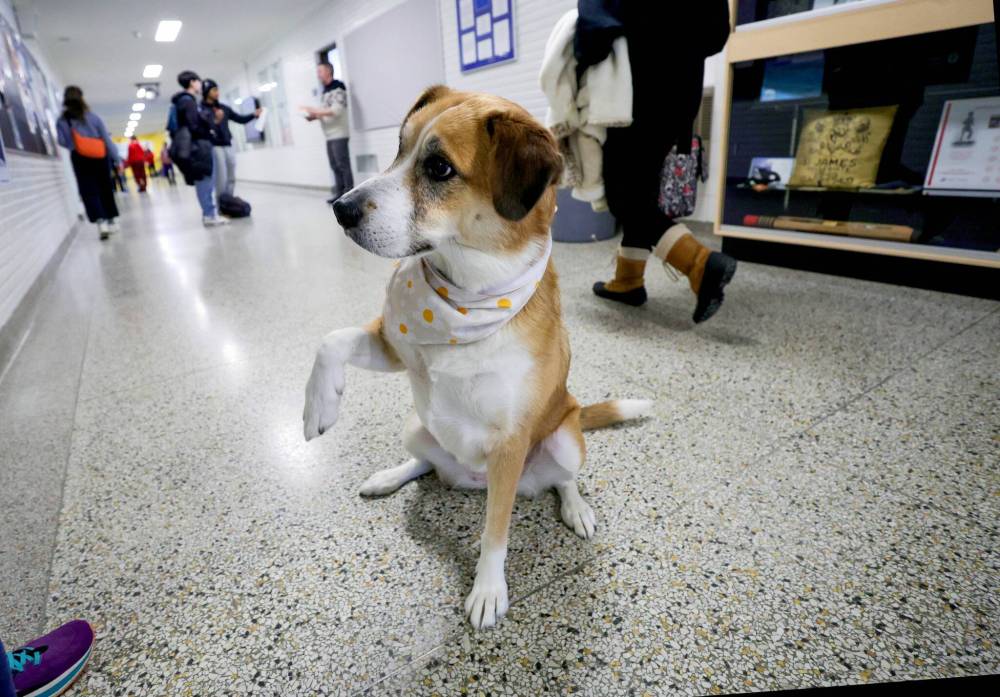Lucy’s owner has hung up her leash after a historic career in the St. James-Assiniboia School Division.
The golden retriever, who is 10 1/2 years old, retired late last year, but left a lasting pawprint.
The beloved canine — the first of her kind to become an in-school therapist — has led an ever-growing pack since she began working at George Waters Middle School in Winnipeg in February 2019.
RUTH BONNEVILLE / WINNIPEG FREE PRESS
St. James Collegiate Grade 9 student, Kat Aseron, is all smiles as she pets Charlie, a canine trained in supporting students and staff with stress and behaviour challenges. Charlie is one of the division’s newest additions to its therapy-dog-in-residence program.
“The more people that are open to the idea to help the kids, the better,” said Myriame Orloff, a guidance counselor who successfully pitched bringing the dog into her workplace to help students regulate their emotions.
Over the last five years, the division has welcomed four other therapy dogs into its schools: Charlie, Berkley, Daisy and Piper. Two other buildings are finalizing details to house their own furry recruits, so staff and students can benefit from being around an animal throughout the week.
Public health Prof. Colleen Anne Dell said the COVID-19 pandemic, during which many people adopted new animals, sparked widespread understanding of the role pets can play in promoting positive mental health.
“Those who had pets were able to reflect and just be present with them,” said the founder of the PAWSitive Connections Lab at the University of Saskatchewan. “I think that opened the door to having therapy dogs more recognized for their support.”
Studies have repeatedly shown interacting with a dog increases a human’s “feel good” hormones, including oxytocin and dopamine, while reducing stress levels. Some research suggests petting a dog can also lower one’s heart rate and improve heart health overall.
Robyn King, head secretary of St. James Collegiate, was among the Manitobans who brought home a pandemic puppy in 2020. Daisy, a sheprador (Labrador-German shepherd mix), has since become a staple in the high school’s office and hallways.
She has no shame when it comes to dropping down, rolling over and waiting for belly rubs during class changeovers, said King, adding more visitors have begun frequenting the main office since the dog started showing up multiple times a week.
Grade 9 student Kat Aseron arrives at her first-period classroom early to sit down with Charlie, St. James Collegiate’s other emotional support dog, for 15 minutes before English Language Arts.
“Seeing Charlie first thing in the morning makes me really happy,” the 15-year-old said, adding the routine has improved her overall well-being and ability to focus throughout the day.
Aldrin Javier, 14, echoed those comments. “It’s just a great way to start the day,” he said about seeing Charlie and Daisy roaming the halls in the mornings.
Charlie is a walking bundle of joy, a conversation starter and the most popular staff member in the building, said teacher (and dog owner) Geret Coates. “I think having a dog in a school is a fantastic tool for building some empathy and some compassion for someone else.”
Coates noted the golden retriever especially has been a welcome addition in recent weeks, as high school students resume provincial exams following a pandemic hiatus.

RUTH BONNEVILLE / WINNIPEG FREE PRESS
Daisy, hanging out in the halls with students at St. James Collegiate Wednesday.
Given therapy dogs are non-judgmental and very savvy at reading human emotions, they make students feel both accepted and grounded, said Darlene Chalmers, an associate professor of social work who studies service dogs at the University of Regina.
The veteran therapy dog handler said perfect canine candidates have a calm temperament, extroverted personality and enjoy being in public settings with different noises, smells and strangers.
A dog’s breed does not matter, but in order to become certified — be it through St. John Ambulance Therapy, Canine Good Neighbour Program or otherwise — they require basic obedience skills.
George Waters administration organized a farewell assembly for their trail-blazing canine before the winter break. There were handmade cards, treats and emotional goodbyes at the middle school.
“(Lucy) was tired. It takes a lot out of her, being ‘on’ all the time; I started to see the slowdown,” said her owner, who brought the golden retriever in once per week (therapy dogs don’t typically work every day in order to prevent burnout).
The canine’s retirement plans?
“A lot of naps,” Orloff said.
maggie.macintosh@freepress.mb.ca









